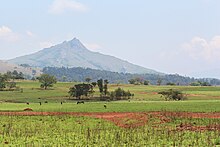Geography of Eswatini
This article needs additional citations for verification. (April 2022) |



Climate
The climate varies from
| Climate data for Mbabane | |||||||||||||
|---|---|---|---|---|---|---|---|---|---|---|---|---|---|
| Month | Jan | Feb | Mar | Apr | May | Jun | Jul | Aug | Sep | Oct | Nov | Dec | Year |
| Mean daily maximum °C (°F) | 24.9 (76.8) |
24.5 (76.1) |
24.1 (75.4) |
22.6 (72.7) |
21.4 (70.5) |
19.3 (66.7) |
19.8 (67.6) |
21.3 (70.3) |
23.2 (73.8) |
22.8 (73.0) |
22.5 (72.5) |
23.7 (74.7) |
22.5 (72.5) |
| Mean daily minimum °C (°F) | 14.9 (58.8) |
14.5 (58.1) |
13.4 (56.1) |
11.0 (51.8) |
7.9 (46.2) |
4.7 (40.5) |
4.6 (40.3) |
6.6 (43.9) |
9.5 (49.1) |
11.3 (52.3) |
12.9 (55.2) |
14.2 (57.6) |
10.5 (50.9) |
| Average rainfall mm (inches) | 253.2 (9.97) |
224.6 (8.84) |
151.6 (5.97) |
87.9 (3.46) |
33.8 (1.33) |
19.4 (0.76) |
20.1 (0.79) |
35.1 (1.38) |
69.4 (2.73) |
141.9 (5.59) |
197.8 (7.79) |
206.9 (8.15) |
1,441.7 (56.76) |
| Average rainy days | 16.9 | 14.3 | 13.8 | 9.8 | 5.1 | 2.8 | 3.1 | 6.5 | 9.2 | 14.9 | 17.0 | 16.5 | 129.9 |
| Source: World Meteorological Organization[1] | |||||||||||||
| Climate data for Big Bend | |||||||||||||
|---|---|---|---|---|---|---|---|---|---|---|---|---|---|
| Month | Jan | Feb | Mar | Apr | May | Jun | Jul | Aug | Sep | Oct | Nov | Dec | Year |
| Mean daily maximum °C (°F) | 32.2 (90.0) |
31.7 (89.1) |
30.6 (87.1) |
29.1 (84.4) |
27.0 (80.6) |
25.2 (77.4) |
25.2 (77.4) |
26.5 (79.7) |
28.4 (83.1) |
29.8 (85.6) |
30.2 (86.4) |
31.6 (88.9) |
29.0 (84.1) |
| Daily mean °C (°F) | 26.2 (79.2) |
26.0 (78.8) |
25.0 (77.0) |
22.8 (73.0) |
19.9 (67.8) |
17.3 (63.1) |
17.1 (62.8) |
19.0 (66.2) |
21.4 (70.5) |
23.4 (74.1) |
24.3 (75.7) |
25.6 (78.1) |
22.3 (72.2) |
| Mean daily minimum °C (°F) | 20.3 (68.5) |
20.4 (68.7) |
19.5 (67.1) |
16.6 (61.9) |
12.8 (55.0) |
9.4 (48.9) |
9.1 (48.4) |
11.5 (52.7) |
14.5 (58.1) |
17.1 (62.8) |
18.5 (65.3) |
19.6 (67.3) |
15.8 (60.4) |
| Average precipitation mm (inches) | 98 (3.9) |
75 (3.0) |
63 (2.5) |
32 (1.3) |
20 (0.8) |
9 (0.4) |
9 (0.4) |
12 (0.5) |
31 (1.2) |
51 (2.0) |
79 (3.1) |
82 (3.2) |
561 (22.3) |
| Source: Climate-Data.org [2] | |||||||||||||
| Climate data for Manzini | |||||||||||||
|---|---|---|---|---|---|---|---|---|---|---|---|---|---|
| Month | Jan | Feb | Mar | Apr | May | Jun | Jul | Aug | Sep | Oct | Nov | Dec | Year |
| Mean daily maximum °C (°F) | 28.2 (82.8) |
28.1 (82.6) |
27.3 (81.1) |
26.0 (78.8) |
24.0 (75.2) |
22.2 (72.0) |
22.0 (71.6) |
23.6 (74.5) |
25.3 (77.5) |
26.4 (79.5) |
26.8 (80.2) |
27.9 (82.2) |
25.6 (78.2) |
| Daily mean °C (°F) | 23.0 (73.4) |
23.0 (73.4) |
22.1 (71.8) |
20.1 (68.2) |
17.2 (63.0) |
15.0 (59.0) |
14.6 (58.3) |
16.6 (61.9) |
18.7 (65.7) |
20.5 (68.9) |
21.5 (70.7) |
22.6 (72.7) |
19.6 (67.3) |
| Mean daily minimum °C (°F) | 17.9 (64.2) |
17.9 (64.2) |
16.9 (62.4) |
14.3 (57.7) |
10.5 (50.9) |
7.8 (46.0) |
7.3 (45.1) |
9.6 (49.3) |
12.2 (54.0) |
14.7 (58.5) |
16.2 (61.2) |
17.3 (63.1) |
13.6 (56.4) |
| Average precipitation mm (inches) | 145 (5.7) |
133 (5.2) |
100 (3.9) |
54 (2.1) |
26 (1.0) |
15 (0.6) |
15 (0.6) |
19 (0.7) |
45 (1.8) |
84 (3.3) |
119 (4.7) |
126 (5.0) |
881 (34.6) |
| Source: Climate-Data.org [3] | |||||||||||||
Physical geography

The terrain largely consists of
As a landlocked country, Eswatini has neither coastline nor maritime claims. In terms of land boundaries, Eswatini borders Mozambique for 105 kilometres (65 mi) and South Africa for 430 kilometres (270 mi), giving a total land boundary length of 535 kilometres (332 mi).
Natural resources
Eswatini's natural resources are asbestos, coal, clay, cassiterite, hydropower, forests, small gold and diamond deposits, quarry stone and talc.
670 square kilometres (260 sq mi) of the country's land is irrigated. The following table describes land use in Eswatini:
| Use | Percentage by area |
|---|---|
| Arable land | 9.77 |
| Permanent crops | 0.7 |
| Other | 89.53 |
Environment

Eswatini is prone to
is a growing problem.Eswatini is part of the following international agreements:
Extreme points
This is a list of the extreme points of Eswatini, the points that are farther north, south, east or west than any other location.
- Northernmost point - unnamed location of the border with South Africa immediately north of the village of Horo, Hhohho Region
- Easternmost point - the tripoint with South Africa and Mozambique, Lubombo Region
- Southernmost point - unnamed location on the border with South Africa, Shiselweni Region
- Westernmost point - a longitudinal segment of the border with South Africa, Manzini Region (not a single point)
References
- ^ "World Weather Information Service – Mbabane". World Meteorological Organization. Retrieved 21 December 2015.
- ^ "Climate: Big Bend". Climate-Data.org. Retrieved August 26, 2019.
- ^ "Climate: Manzini". Climate-Data.org. Retrieved August 26, 2019.
External links
- European Digital Archive on the Soil Maps of the world - soil maps of Swaziland
